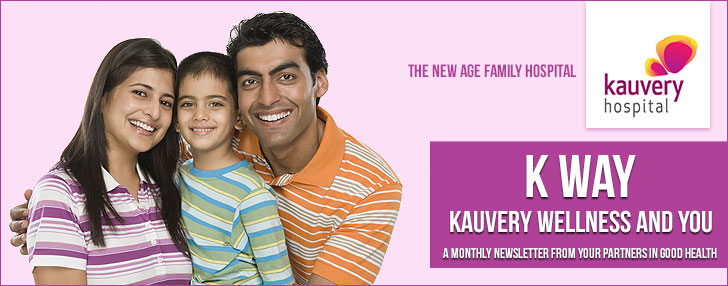
From the Director’s Desk
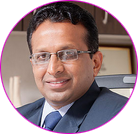
The rains are gone, but there’s water everywhere. This is the grim aftermath of the floods that struck Chennai early this month. But through all this, the one thing that never sunk was the spirit of Chennai. Now that the floods have passed, we must not let up on the spirit that propelled us to unimaginable acts of bravery, kindness and sacrifice.
Now comes the rebuilding. After any natural disaster, a city requires a lot of help to get back on its feet. But most of this help can and has to come from the only people that truly matter. The people of Chennai. We have to first acknowledge that rebuilding the city is the need of the hour and the best way to do it is to rebuild ourselves.
This is precisely what everyone at Kauvery Hospital did during the peak of the crisis. Doctors, nurses, support staff, technicians and administrators came together to keep services running on a war footing, from sourcing oxygen and fuel for generators to keeping dialysis units functioning. Most of the doctors and staff stayed back in the hospital to ensure the safety of the patients, despite their houses being inundated and their own families affected. My sincere gratitude to them.
We conducted more than 50 health camps, treated several thousand people, distributed free medicines and provided relief material. Many of our doctors and staff volunteered for these camps.
The floods were definitely a disaster of epic proportions that will be etched in our memories forever, but through the dark clouds of hopelessness we are glad we could shine a sliver of light to help those we could. This crisis was definitely a learning experience for us. We stood together as a team and managed to successfully help our patients make it through the floods.
It is also heartening to see the citizens of Chennai take on the onus of getting the city back on track during the Marghazhi festival, by performing or attending concerts, a much needed psychological relief at this time.
At the dawn of a new year, Kauvery hopes to continue its efforts with renewed zeal and commitment. The coming months will see the launch of new departments and services and we at Kauvery wish the citizens of the city a happy, healthy and peaceful 2016.
Dr Aravindan Selvaraj, MS Ortho, FRCS Ortho (UK & Ireland)
Executive Director & Chief Orthopaedic Surgeon, Kauvery Hospital

Wishing You and Your Family a Very Happy and Prosperous New Year 2016!
– From Everyone of Us at Kauvery Hospital
10 New Year Resolutions, you can definitely keep.
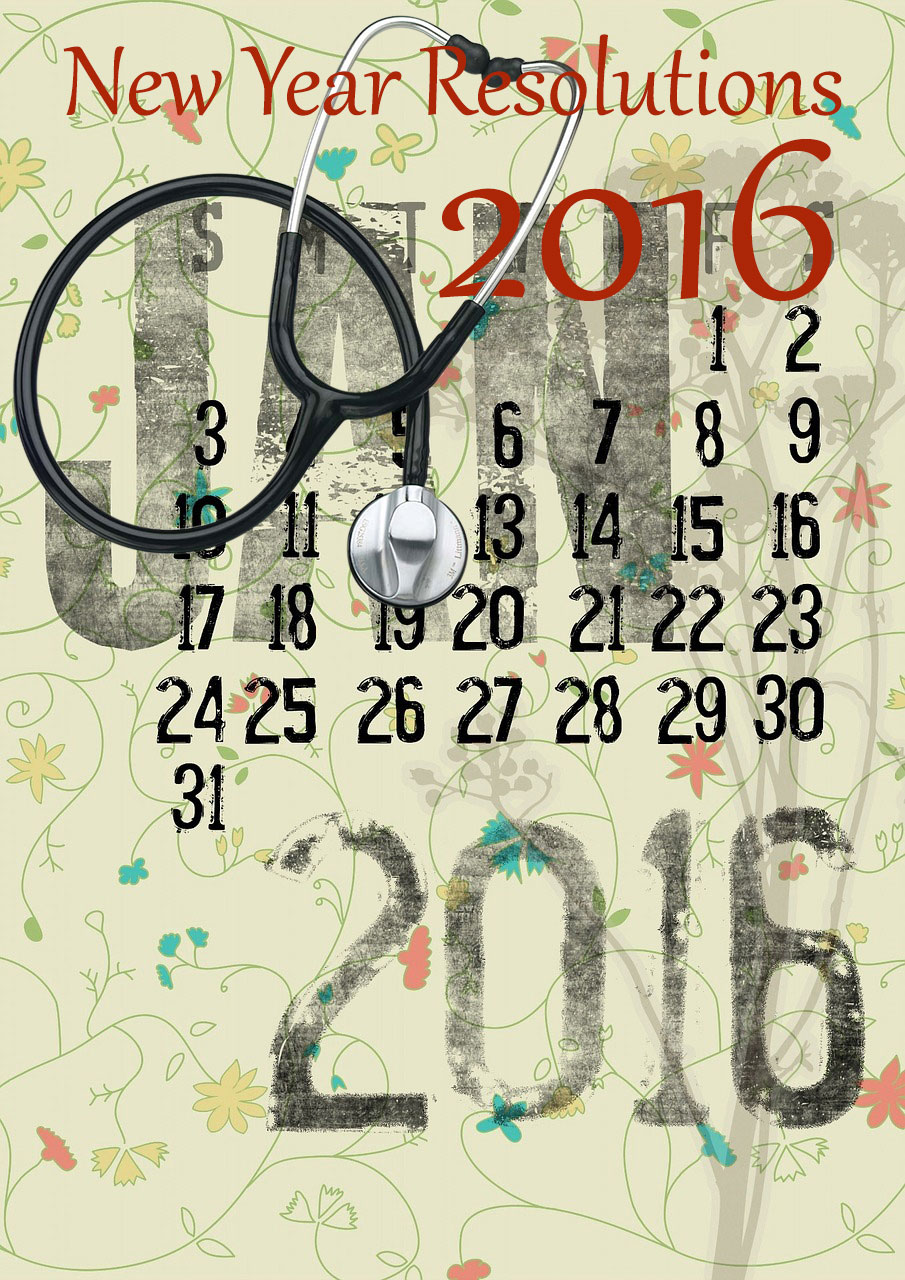
- Walk 20 minutes everyday
- Turn off devices and spend more time with spouse
- Appreciate more
- Drive less and walk more
- Take your child for a monthly fun outing
- Eat Healthy with one meal with family at the table
- Sleep better
- Write a To Do List everyday and tick off as you complete
- Break at least one bad habit this year
- Buy less and reuse more
Hypertension: The Silent Killer
Article by Dr. R Balasubramaniam, Senior Consultant Nephrologist, Kauvery Hospital

Systemic hypertension, more often known as High Blood Pressure or simply BP, is one of the commonest diseases related to life style. According to a 2014 research report that was published in the Journal of Hypertension, an alarming 29.8% of the entire Indian population is suffering from hypertension In other words, one in three Indians is a victim of this disease.
It is called the ‘Silent Killer’, because it gives no warning and many people do not know they have hypertension. Over time they become exposed to serious risks of heart disease, stroke and kidney failure. Increasing stress levels, obesity, sedentary life style, smoking and changing dietary habits are all responsible for this illness.
What is blood pressure?
When your heart pumps blood, the force of oxygenated blood pushes against the walls of the thick muscular tubes called arteries. Blood flows with this force through these tubes to various parts of your body. This force of blood is called blood pressure. When it happens to be too high, it becomes an illness known as high bood pressure. With the help of the BP equipment, your doctor actually reads two aspects of your blood pressure:
1. Systolic Pressure: Pressure of blood when your heart beats while pumping blood.
2. Diastolic Pressure: Pressure of blood when your heart is at rest between beats.
A blood pressure less than 120/80 mmHg (read out as 120 over 80 millimetres of mercury) for an adult is considered normal. The first number 120 indicates systolic pressure, and the second number 80 indicates diastolic pressue. You are called ‘Pre hypertensive’, if your systolic blood pressure is between 120-139 and diastolic pressure between 80-89. Blood pressure reading greater than 140/90 indicates hypertension.
Essential hypertension
There are no underlying identifiable causes for this illness in about 85-90% of the reported cases: this type of hypertension is called ‘Essential hypertension’; but it has been linked to risk factors such as increased salt sensitivity,family history, age and race.
Secondary Hypertension
The remaining 10-15% of the patients with hypertension have identifiable underlying reasons for their increased blood pressure; examples include kidney diseases and a few endocrine diseases related to thyroid, adrenals, and narrowing of the main vessel in the arterial network (coarctation). This type of hypertension is called ‘Secondary Hypertension’.
How to identify secondary hypertension?
Indications of secondary hypertension include sudden onset of hypertension before 25 or after 55 years of age, hypertension that is difficult to control, hypertension that needs multiple antihypertensive drugs, hypertension associated with swelling of the legs, or protein leakage in the urine, low hemoglobin and kidney failure. But every hypertensive patient should not be suspected to be a case of secondary hypertension.
What to do when your blood pressure is high?
The first step is to exclude secondary hypertension. The basic steps to follow would be early CHANGES IN LIFE STYLE: this includes 30 minutes of brisk walking or any moderate exercise, reduction of dietary salt by 50 % and reduction of 5 kg of body weight. By following these steps, mild increase in blood pressure can be controlled, without the need for medications.
If pressure remains high in spite of these measures or if the initial blood pressure itself is high, then you need medications.
What are the measures to be taken if your blood pressure is high?
Continue life style modification. Take blood pressure medications regularly. Monitor your blood pressure regularly. Monitor annually the well-being of the heart, kidneys and brain.
Why should you control blood pressure?
Uncontrolled blood pressure can lead to acute and long term complications. The commonest acute complication is heart failure, when the pressures are too high. Long term uncontrolled blood pressure leads on to increased risks of heart attack, heart failure, and stroke and kidney failure.
The good news is that well-controlled blood pressure decreases the risks of these life-threatening complications.
What else should you do to ensure good blood pressure control?
Home blood pressure monitoring: Like blood sugar monitoring, this is ideal to track the level of your blood pressure control.
24-hour blood pressure monitoring: Also known as Ambulatory Blood Pressure Monitoring, this will make available your blood pressure pattern over a 24-hour day-night period. It is useful in identifying the following two most important variables, which are necessary to study the quality of your sleep and general health in relation to your hypertension and risks of diseases:
1. ‘Blood pressure dipping pattern’: Normally your blood pressure is expected to fall by 10 to 20% when you sleep; if it happens so, you are called a dipper, and the pattern of fall, BP dipping pattern. In about one-fifth of the population, blood pressure may not dip and such patients are non-dippers. In certain other patients there may even be an alarming increase: those patients are reverse dippers. They run an increased risk of heart attack and stroke.
2. ‘Early morning surge in blood pressure’: A few patients who have night-time dipping of blood pressure may register an abrupt increase in the early morning. Win over the silent killer, and live a long, peaceful, healthy and happy life.
Abdominal Pain – Symptoms, Causes and Treatments
Abdomen is called the “Temple of Surprises”. Abdomen has got 9 compartments. The upper abdomen, the middle abdomen and lower abdomen are divided into 3 compartments each. The major organs in upper right quadrant are the liver and gall bladder, in the middle upper portion we have the stomach, in the upper left quadrant is the spleen, in the middle abdomen on both sides we have the kidneys, in the middle portion we have pancreas, transverse colon and small intestine. In the lower abdomen, on the right lower quadrant we have the appendix, in left lower quadrant we have the large intestine’s terminal portion and in the middle lower portion we have rectum as well as the urinary bladder. The abdominal pain can be related to the organs underlying the particular area. Sometimes we call this as the radiating pain. For example a person with heart attack can have severe pain in the upper part of the abdomen.
Prof. D. Kannan, Senior Consultant Surgical Gastroenterologist at Kauvery Hospital, talks about abdominal pain symptoms, its causes and treatment.
The Ignored Ache
Article by Dr. Yamini Kannappan, Psychiatrist, Kauvery Hospital

No textbook of Psychiatry could have taught me better to decode and to comprehend the sufferings of the unrest mind as patients do.
This patient walked me through the agonies of his mind which was fast sinking through unfathomable depths and a mind which kept trying hard with utmost rationality to decipher the reasons behind the struggle. I have never understood Depression better.
“I am no longer what I am doctor…” and thus he started his narration and his ordeal with his mind. It started with nagging headaches and near constant aches that refused to wash away with cups of caffeine or pain killers. Gradually unending episodes of fatigue & exhaustion started sapping me up and I realised that it was not just physical any more. My mind refused to lighten up. The smiles of my children were no longer contagious, music and television appealed to me no more. I stopped reading and talking to my friends..the world no longer mattered to me..The most minuscule acts of daily life like showering or dressing seemed totally overwhelming. I remember the dreadful long hours I looked at the comb with an absolutely shocking lack of will and drive to groom myself. Darkness loomed large and my mind kept rapidly filling up with irritatingly repetitive thoughts of doom, dread and catastrophe. I wished to sleep it all off but I realised that darkness was even more agonising. Sleeplessness haunted me..My wishes to end it all kept growing by the day. I feared the day when my death instincts would overpower my reasons to live. Panic and uncertainty kept ripping through me..I kept cuddling up near my child just like an infant wanting to be nursed. I wanted to be embraced, wanted something or someone to get rid of my soul shattering pain. I failed to find a reason try as I might. I am no longer a father, a husband, a boss ..I am no longer what I am doctor”
The sufferings of a depressed mind cannot be explained better. Depression is a medical disorder. It is one of the biggest public health challenges because of its high incidence. Research globally as well as in India suggests that at least one in 5 women and one in 10 men suffer from major depressive disorder at sometime in their lifetime. Medical science has given neurobiological underpinnings to the disorder. Genes, faulty neural circuits, abnormal levels of chemical messengers in the brain can all be important causal variables. Psychosocial factors like recent losses, relationship failures, and stressful environment intertwine with biological vulnerability leading to this illness. It is time to clear common misperceptions of the illness.
1. It is important to understand that Depression need not have a psycho social cause all the time. In several cases it occurs out of the blue. It is then called an endogenous or melancholic depression which endorses the biological nature of the problem.
2. Having a Depressive Disorder does not equate with ‘weakness of mind’. In fact the strongest willed are sometimes more susceptible to it.
3. Depressive Disorder can be treated. Pharmacotherapy, psychotherapy or a combination of both works. What works for whom is decided by the mental health professional on the basis of the severity of the illness, symptom profile and cause.
4. Anti depressants work by helping regulate the disordered brain chemistry and are not sedatives as widely believed.
5. The usual course of treatment is between 6-9 months and not life long as widely misconceived. Being in good health includes being in good mental health.
Let’s fight and help fight those with the ache in the psyche. Let’s fight depression! Only then you can be truly who you are!
Ask The Doctor
- Doctor, we are a little apprehensive, as my husband has been advised to undergo treatment for hernia. What exactly is hernia and what may we expect?
- Hernia is a condition found to occur commonly in men, women and children too. It is a rupture that occurs when a part of an organ or tissue bulges and protrudes through the lining muscle of the cavity containing that organ. This is generally caused by muscular strain, injury, weakness of that muscle, etc.
For example the strain of lifting heavy objects may contribute to a hernia, especially when the abdominal lining muscle is weak. People born with such a weak muscle are at risk of developing a hernia. Hernias most commonly occur in the abdomen but can occur elsewhere too. They are typically categorized as follows.
Inguinal hernia
Inguinal hernia is a rupture at a weak spot in the abdominal muscles: a part of the intestine or of the membrane lining the abdominal cavity protrudes through the rupture, The ensuing bulge can be particularly painful when coughing, bending over or lifting heavy objects.Generally an inguinal hernia is not dangerous; neither does it get better, nor disappear with time. If not treated, then it can cause life-threatening complications. It is therefore necessary to repair a painful hernia, for which surgical treatment ensuing laparoscopy is recommended. It is a common, routine procedure.
Umbilical hernia
This hernia creates a soft swelling or bulge near the navel. It occurs when part of the intestine protrudes through the umbilical opening in the abdominal muscles. Most commonly, it occurs in infants and toddlers in the age group of 1-2 years, but usually closes on its own.Incisional hernia
Incisional or ventral hernia occurs on the abdominal wall following a surgical incision made on the belly. It can happen months or even years after surgery. Most of the time, it occurs along a vertical (up and down) incision.Hiatal hernia
Also known as Hiatus Hernia, it occurs when a part of the stomach pushes up through the small opening (hiatus) in your diaphragm – a muscle that separates the chest cavity from the abdominal cavity. There are two types of hiatus hernia – paraesophageal and sliding hernias.Congenital Diaphragmatic hernia
Congenital Diaphragmatic Hernia occurs in the fetus (an unborn child developing in the womb), during its development, when the diaphragm does not fully develop. Thus the gaping hole left wide open allows the abdominal organs to push their way up into the chest cavity.Treatment
Hernias are generally repaired by surgery. Untreated hernias apart from being painful, can cause health problems. - Doctor, what could be the reason for hemorrhoids to develop?
- ‘Hemorrhoids’ is the medical term for the condition more commonly known as Piles. They are a mass of swollen rectal or anal blood vessels. These veins are situated in the lower part of the anus and rectum. Hemorrhoids are of two types:
- Internal
- External
Internal hemorrhoids lie deep inside the rectum and are not normally visible to the naked eye. They don’t usually hurt, but their presence is marked with the symptom of bleeding through the anus.
External hemorrhoids get formed in the anal region and create discomfort. When an external hemorrhoid protrudes through the anus, it can be seen and felt. Sometimes blood clots can form within the mass that slips down; it can be extremely painful.
Causes for formation of hemorrhoids
- Diet: This is the primary reason for the formation of hemorrhoids. Low fiber diets, highly processed foods and inadequate intake of water can all cause piles.
- Elderly people and pregnant women are, in general, likely to develop hemorrhoids.
- A family history of weak rectal veins may be another cause.
- Excessive abdominal pressure due to obesity, pregnancy, prolonged standing or sitting, coughing, straining on the toilet, holding on to your breath during labor, vomiting and sneezing can all cause hemorrhoids.
Symptoms
- Bright red bleeding from the anus: blood may streak the toilet paper or bowel movement
- Swollen, painful lump near the anus
- Itching
- Pain and tenderness during bowel movements
- Mucus discharge
Treatment Options
- Topical creams, ointments and suppositories
- Sitting in warm water or sitz bath: A bathtub shaped like a chair in which one bathes in a sitting position, immersing only the hips and buttocks.
- Painkillers
- Sclerotherapy Injections: An internal haemorrhoid can be injected with a solution that creates a scar and closes off the haemorrhoid. The injection will only hurt a little.
- Banding: A special tool secures a tiny rubber band around the haemorrhoid, shutting off its blood supply almost instantly. Within a week, the haemorrhoid shrivels and falls off.
- Coagulation: Using either an electric probe, a laser beam, or an infrared light, a tiny burn painlessly seals the end of the haemorrhoid, causing it to close off and shrink.
- Surgery: For large internal haemorrhoids or extremely uncomfortable external haemorrhoids, your doctor may choose traditional surgery, called haemorrhoidectomy.
Flooding and Communicable Diseases
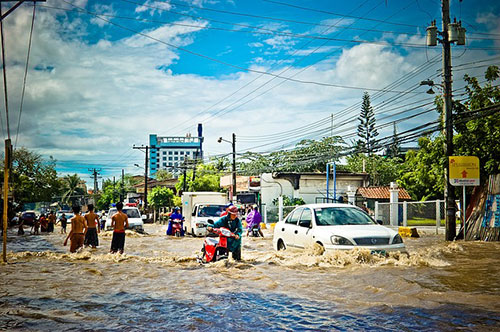
Chennai, Kancheepuram and Tiruvallur Districts of Tamil Nadu experienced unprecedented amounts of rain, followed by devastating floods in the first week of December, 2015. The immediate need of the hour in these areas is to take precautionary measures to prevent post-flood epidemic outbreak of communicable diseases. Against the backdrop of typical tropical climate, these three districts are at an increased risk of the outbreak of the following communicable diseases.
- Waterborne diseases such as Typhoid, Leptospirosis, Hepatitis A and Cholera
- Diseases such as Dengue Fever, Malaria, Yellow fever and Hemorrhagic Fever spread mainly by mosquitoes
When there is a significant displacement of population and when post-flood water sources become contaminated, the potential of an epidemic of such diseases is rather high. Of the diseases named, Cholera is one dreaded disease to be doubly guarded against.
Causes, Symptoms and Treatment of Cholera
The bacteria Vibrio Cholerae that cause this dangerous disease can contaminate easily the following common sources of food and drink.
- Food and drinks sold by street vendors
- Ice made from municipal corporation water
- Municipal water supplies
- Raw or undercooked fish/seafood caught in polluter waters, especially if contaminated by sewage
When food prepared with contaminated water is eaten, or contaminated water is drunk, the bacteria release a toxin that produces severe diarrhea.
Symptoms
The symptoms of cholera can be noticed as soon as a few hours, or in about 5 days after the infection has occurred. Symptoms are often mild, but sometimes they can be very serious too. One in 20 may have severe watery diarrhea together with vomiting.
Diarrhea accompanied by vomiting can lead to dehydration. Even people only mildly affected are potential carriers of the infection; if they are not identified and treated immediately, the illness can spread quickly from them, causing an epidemic.
Dehydration will lead to:
- Low blood pressure
- Rapid heart beat
- Loss of skin elasticity
- Increased thirst
- Dry mucous membrane in the nose, as well as the mouth, eyelids and throat
- Muscle cramps
When dehydration is left untreated, it can lead to shock and consequently certain death, in a matter of hours.
Treatment
Though a vaccine is available to prevent cholera, its effects last only a few months and it may not save one in two who receive it; taking other precautionary measures, therefore, for prevention of the infection is a much better solution.
The mainstay of treatment for cholera is to stay hydrated. Depending on the severity of the diarrhea, the treatment will comprise oral medications or intravenous solutions, to compensate the loss of fluids from the body. In mild cases, antibiotics may be prescribed but not as part of emergency care treatment.
Protective Measures
Ensure that you use only boiled, chemically treated, disinfected or bottled water for the following purposes:
- Drinking
- Preparation of food or beverages
- Washing vegetables, fruits and other edible products that require to be washed
- Making ice
- Washing hands and face
- Brushing teeth
- Washing utensils and dishes used to prepare food or to serve
To ensure that you have clean water, boil water for a minute, filter, and add a commercial chemical to disinfect.
Furthermore, avoid eating raw foods, including:
- Raw and undercooked meat or seafood
- Unpeeled fruits and vegetables
- Fish caught in waters which could be contaminated
- Unpasteurized milk or milk products
In the event of developing watery and severe diarrhea self or any other, please notify and seek immediate medical help. Cholera is treatable if reported promptly, but the ensuing dehydration can cause serious complications, and therefore it is important to seek treatment immediately.
Events of the past month
Kauvery Hospital organized 33 Flood Relief Camps
Thousands of people benefitted in 33 Flood Relief Medical Camps organized by Kauvery Hospital in EID Parry, Ice House, KK Nagar, Kolathur, Korattur, MKB Nagar, MRTS Greenways Road, T Nagar, NCR Mahendracity and Thiruvannamalai recently. Free medicines were distributed during the medical camps.
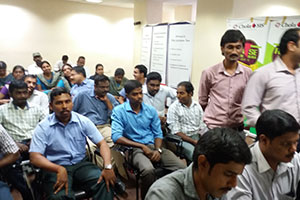
EID Parry, Parrys Corner – In EID Parry, the employees were vaccinated with Hepatitis B vaccine, Flu vaccine, and Tetanus injection after the flood. More than 300 employees were benefited from this medical camp, which was held at their corporate office on 16th & 17th December 2015.
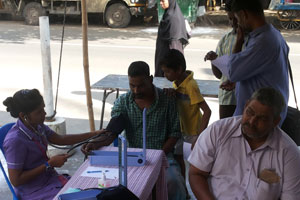
Ice House (Triplicane) – Flood Relief Medical Camp was conducted along with Rotary Club of Madras East on 14th December 2015. More than 300 flood affected people were screened by the physicians and preventive measures were given against communicable diseases breakout. Free medicines, syrups and ointments were given to the patients.
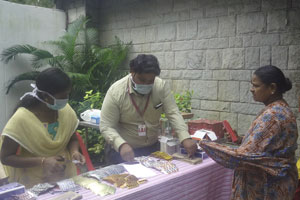
KK Nagar – Flood Relief Medical Camp was conducted along with Tamilnadu Government on 10th December 2015. More than 400 flood affected people were screened by the physicians and preventive measures were given against breakout of communicable diseases. Free medicines, syrups and ointments were given to the patients. Children were also screened and given medicines for cough and cold.
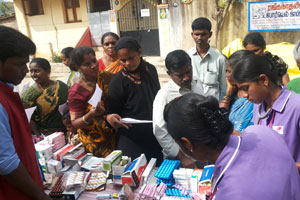
Kolathur – Flood Relief Medical Camp was conducted along with Big FM on 17th December 2015. More than 150 flood affected people were screened by our physicians. Free medicines, syrups and ointments were given to the patients.
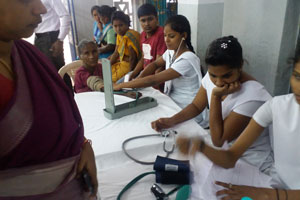
Korattur – Flood Relief Medical Camp was conducted along with WABCO Corporate as part of their CSR Activity on 19th December 2015. More than 200 flood affected people were screened and free medicines were given to the patients.
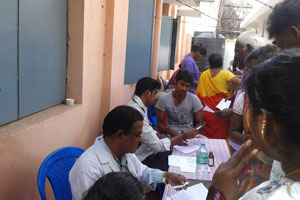
MKB Nagar – A Medical Camp was conducted along with Hyath Foundation on 19th December 2015. More than 300 flood affected people got benefitted during the camp.
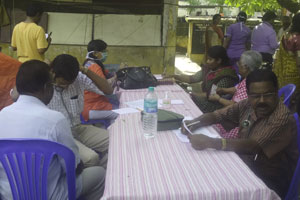
MRTS Greenways Road – Flood Relief Medical camp was conducted along with a group of RA Puram residents as volunteers on 13th December 2015 and 2500 people were screened and got benefitted.
Wellness Talk on Communicable Diseases’ Prevention and Treatment
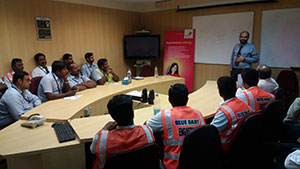
A wellness talk was given by Dr. Iyappan Ponnuswamy on communicable diseases, prevention and treatment to the staff of Blue Dart Cargo corporate office at Chennai Airport. Around 100 staff members participated in this event.
70th State Conference TIMACON-2015
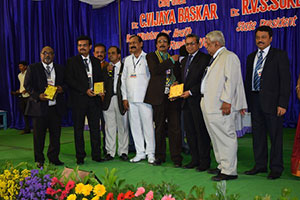
IMA Chennai Kauvery Alwarpet Branch received 8 awards at the 70th State Conference TIMACON-2015 held at Vellore on 12th December 2015 for Best Branch, Best Secretary, Best President, Best CME Activities, Best Journal, Best Membership Contribution to IMA, Best Community Activity and for Best Doctors Day Blood Donation Camp.
Upcoming Events
General Medical Camp at Besant Nagar
Kauvery Hospital will conduct a general medical camp at Besant Nagar on 17/01/2016.
Cardiology Camp at Arakkonam
Kauvery Hospital will organize a Cardiology camp at Arakkonam on 02/01/2016.
Cardiology Camp at Ambur
A Cardiology camp at Ambur will be organized by Kauvery Hospital on 23/12/2015.
Cardiology Camp at Pudukkottai
Kauvery Hospital will conduct a Cardiology camp at Pudukkottai on 24/01/2016.
General Medical Camp at Jolarpettai
Kauvery Hospital will conduct a general medical camp at Jolarpettai on 29/01/2016.
Cardiology Camp at Perambur
Kauvery Hospital in association with Jupiter Surgical Specialty Center will hold a cardiology camp at Perambur on 31/01/2016.
Patient Experience
“The warm, kind and gentle approach of Dr.KPS and Dr.RBS guided us to a speedy recovery of my mother and my heartfelt thanks to both doctors.”
– J.K
“Our special thanks to Dr.Damodharan & Dr.Arvind and all their support for the timely help. Excellent.”
– K.R
“Great experience. Doctors were very prompt and helpful. Kudos to the entire hospital administration doctors and nurse. I will definitely recommend this hospital to my friends and relatives.” – S.K
“Felt very comfortable and I thank the whole team of Kauvery especially, Dr.PremSekar.”
– P.R
“It was so great and never felt that I was hospitalized. It was just like at home with my family. So thankful to all the nursing staff. Do keep it up!”
– P.B
“I didn’t see the hospital staff insisting ER patients to fill in the form or to pay money. They were continuously in touch with the doctors on call duty complying with the procedure. All through my entire stay here I noticed this very polite/courteous and respectful treatment by all staff at all levels which was refreshing. With a little bit of streamlining and organizing, the food and beverages department at Kauvery Hospital can give other multi-specialty hospitals a run for their money. It is on its way there.
Thanks to the entire team!!!”
– H.J
“I wanted to come personally to wish and thank all of you, your team members, all the staff of dialysis department, my doctor Dr. Balasubramaniyam, staff from pharmacy and all the other junior and other senior members a very happy new and a prosperous 2016. May God keep all of you happy, healthy, wealthy, career and business wise progressive in the entire year of 2016.
Though you have done remarkably well all the times to help and got work done for the patients concerned. But what you and your team, specially you did during the recent heavy continuous rain and flood is not only remarkable but should be an example for others to follow. Inspite of all odds you have gone all out of the way to help and support us. We are very happy and proud that we are a patients of Kauvery Hospital and there are people like you who takes ownership and so much proactive. All because of your leadership.
It is your management who should get appreciation for I am sure it is their training that all the staffs are so good and well trained and well behaved. Here I will not talk about the Doctors for they are truly God and gem and know their subjects so well with so much of patients to hear, understand and explain that 75% of the problem patients face automatically vanishes. Really great selections of doctors. Truly a professionally managed world class hospital with best if facilities and people. I never wish, but if anyone falls sick they must go to Kauvery Hospital with eyes closed.”
– A.G
Recipe Corner
Kashmiri Pulao
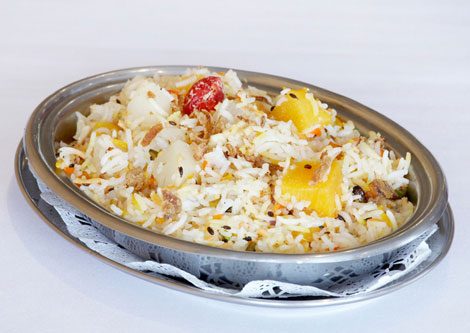
To ring in 2016, the New Year, this authentic Kashmiri Pulao will be the most appropriate New Year lunch/dinner special that will surely be the delight of your table. Rich in flavors but low on calories, this fruity, nutty, aromatic and yummy dish, play on your senses and fill your innards with a glow of delectable satisfaction.
This colorful pulao is prepared for special occasions in the Valley, it is kid-friendly and a great dish to serve your family.
Preparation Time: 30 minutes Cooking Time: 15 minutes Serves: 4
Nutritional Facts: Serving 1 – ½ cup cooked. Calories – 180; Total fat – 9 g; Cholesterol – 8 mg; Carbohydrates – 21 g; Protein – 5 g; Sodium – 42 mg; Potassium – 69 mg; Calcium – 5%; Vitamin C – 17%.
Ingredients
- 2 cups Basmati Rice (India Gate, Daawat or Kohinoor)
- ½ teaspoon Saffron strands
- 1 cup Fresh Coriander leaves (finely chopped)
- 4 tablespoons Ghee
- 1 tablespoon Warm milk
- Salt to taste
Fresh Fruits
- 1 cup Pineapple (chopped into tiny pieces)
- ½ cup Seedless Grapes (either green or purple)
- ½ cup Fresh Orange Juice
Spices
- 3 Cloves
- 1 inch stick Cinnamon
- 4 pods Cardamom
- ¼ teaspoon Black Jeera/Karinjeeragam/Shahi Jeera
- 1 teaspoon Black Pepper Powder
- 1 Bay Leaf
Dry Fruits
- ½ cup dried Cherries
- ½ cup Tutty Fruity (optional)
- 2 teaspoons Raisins (dry grapes)
Nuts
- 2 tablespoons Cashew nuts
- 2 tablespoons Almonds and/or Pistachios (shelled)
Preparation
1. Wash the measured Basmati rice and soak for ½ an hour.
2. Soak the saffron in a tablespoon of warm milk.
3. Place a heavy-bottomed pan on the stove on low heat. Add the ghee and the spices (whole and as listed in this recipe) and sauté for a minute (or until the aroma of the spices fill the air).
4. Add half the quantity of the nuts and dry fruits, keeping aside the other half for garnishing. Sauté for a couple of minutes.
5. Add the fresh fruit and mix well with the other ingredients in the pan.
6. Drain and add the basmati rice to the mix in the pan and sauté for about 3 minutes.
7. Add orange juice and mix it in well.
8. Transfer contents to a rice cooker, adding sufficient water to help cook the rice. (Take into account the orange juice, while adding water).
9. Once cooked, fluff the rice with a fork or lightly mix it. Add the saffron milk mixture. Cover and let the flavors blend.
10. Garnish with the remaining fried nuts and raisins, together with chopped coriander leaves.
Serve warm with vegetable korma or chicken/mutton korma.

